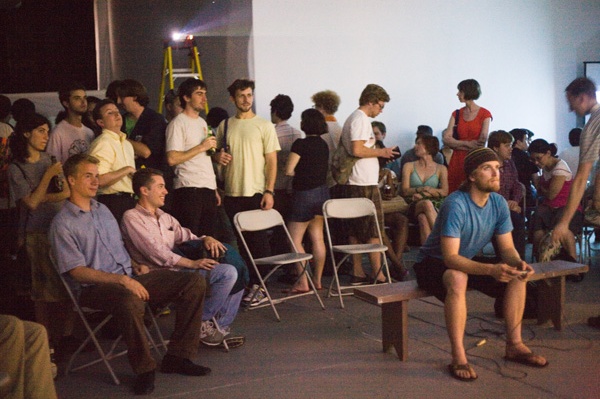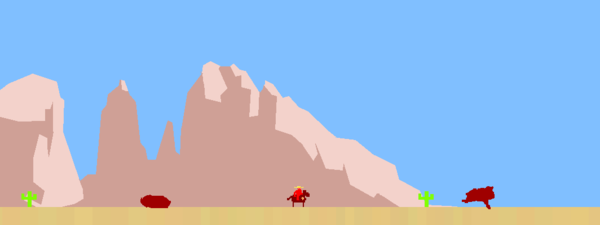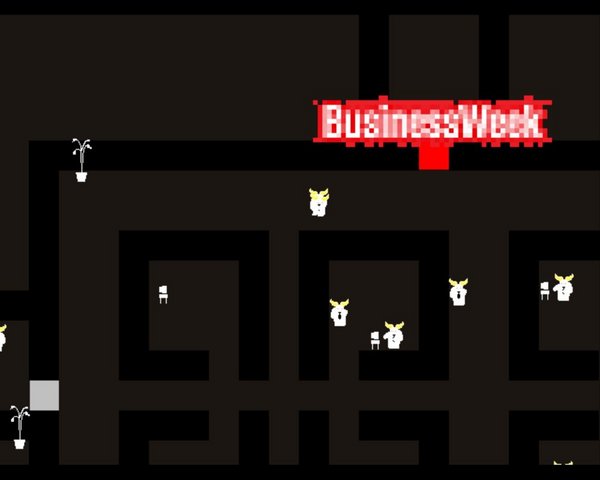This is an archive of the ArtCat Zine, 2007-2009. Please visit our new project, IDIOM.
Talking with Mark Essen
When Mark Essen first started designing video games in high school, he never anticipated that it would make him a name in the art world. Now, not so many years later, Essen is the second youngest artist in the New Museum’s Younger Than Jesus show (limited, of course, to artists under 33) and one of the fastest rising stars in the growing field of video game art. Known for his Atari-inspired designs and black-humor-driven plots, Essen’s games take a page from the 8-bit games of 80s and build on them, adding new aesthetic and thematic layers to cultural objects still ripe with associations of parents’ basements and misspent youth. Creating games that are both frustratingly difficult and undeniably addictive, Essen is a gamer’s designer, a programmer whose format is deceptively simple while the logic behind them isn’t. For those not weaned on the mushrooms of Mario or the asteroid belts of Starfox, Essen’s work may seem to come out of left field, but as the Younger Than Jesus subway ads say, “This is the voice of a generation. Some translation required.” --J.L.
Jessica Loudis for ArtCat: You studied with several filmmakers while you were a student at Bard. Is there a connection between cinema and video games?
Mark Essen: There’s certainly a visual connection, and there’s also a social connection sometimes, like when you get a new game and sit down with it or you’re watching a film for the first time you’re kind of lost at first, trying to grasp the logic of the storytelling or experience. I don’t know if that makes them that related; you could say the same thing about music. I guess the major connection is that both games and films are presented in a similar way, but the role of the audience is different to each. In a movie maybe you’re trying to get into the mind of the director or whatever, in a game you’re thinking about that, the designer, and also the guy playing. Maybe you’re playing too. It’s a process of trying to figure out what the other guy’s thinking.

AC: How do you think difficulty affects the way people perform or interact with your games?
ME: There’s a lot of repetition, so it becomes an endurance test in a way. Punishment 2 is an example of this. At every level you need to go to the top of that level, and at every new level you have to go to the bottom of a tower. So it’s up, down, up, down and on each screen you’re dying fifty times before you beat it, before you can advance. It’s not very fun, I guess. It’s a test of will. If you’re playing the game alone at home it’s just masochistic, but if you go to a party and sit down with someone it becomes cooperative. It takes two hours, maybe, for newcomers to get all the way through it. Meanwhile, a crowd is watching you, they’re coming and going, and you’re on stage.
AC: So do you design your games for these kinds of private spaces, for people's homes, or do you imagine them in art galleries?
ME: Mostly for galleries, but I have a couple of games up on the site that are more for private spaces. I have one game that’s in a language I made up. Over the course of the game you have to figure out how it works and decode everything. The game’s called Bool. You play as a ball. I was going to design this complicated language system, have certain groups of letters represent different groups of letters, that sort of thing, but I ended up making it so that each letter made up a symbol and then those symbols were translated as you bought these objects from the game store. All the menus are in different languages too, and if you buy one certain item you'll restart the game. So that takes about half an hour, maybe an hour to play, and if you played it in a gallery it wouldn’t work.
AC: What’s was the motivation behind that particular game?
ME: I guess from playing imports and Japanese games. It seemed like all the cool ones were in Japanese and I’d download somethink like Front Mission and sort of pick up on how it worked, but not really. Bool is the dream that I could understand Japanese games if I played them long enough.
AC: While most of your games employ an 80s retro aesthetic, they also integrate explicitly contemporary features, such as the disembodied baby photos in Randy Balma. How do you see your work building on these older games?
ME: I think it’s important to let people know that these aren’t games from the 80s. They reference them in some ways, but they also make use of new experiences you just can’t have with the older hardware. One example, games now can run really high frame rates: film’s 24, video’s 30, and games can be 60 or more, if you want. For the last level of Randy Balma, I used these high frame rates to make every other frame a different color. When the screen flashes red and blue, the whole thing becomes purple. Maybe it’s just the video card tearing up, but the smoothness is something that wasn’t possible before. I like experimenting with the aesthetic in ways like that.
AC: When did you start thinking about games in the context of art?
ME: I took a studio art class with Hap Tivey at Bard and made a game for it.
AC: So what changed?
ME: I don’t know. Maybe realizing that ways of approaching and experimenting with forms like film and video could be translated to games, and in doing so the games can become a lot more interesting.
AC: How do you begin to design a game?
ME: I usually start with a movement and I build environments around that. For You Found the Grappling Hook, a friend sent me this code for a grappling hook, and I built a little engine so you could walk and swing, which I played with that for a long time. Eventually, I realized that that was all I wanted to do, so I built some caves, and that was it.
AC: And this eventually morphed into the infamous You Found the Grappling Hook (Pro)…
ME: Well, Businessweek had just introduced this new section called Businessweek Arcade, which highlighted indie games, and they put my grappling game up. They were using my hosting and bandwidth, linking the game directly on my server, which is sort of an Internet taboo. Just because of the unique opportunity, I changed that file they linked to a game where you walk around the Businessweek office, find terrorists, and throw them out the window. If they’re not terrorists, they’ll ask you a question about a Businessweek article, and you have to read the article to answer the question, otherwise they’ll catch you.
AC: That’s pretty good promo, actually. What are some other ideas you’re kicking around for the future?
ME: Well, there are sometimes competitions for "one-switch games," which are games you can play with one button. I was working on this platforming game a while ago where every move is performed through a series of taps and holds. So you have to hold the button to run, tap to change direction, and double-tap to jump. I want to make a game where you beat the level you have to tap out messages in Morse code. You’d be controlling a pony, like the pony express vs. telegraph, and you have to see who can get the message to the end the fastest.
AC: You could market it to elderly war veterans. Have you thought about designing any cabinet-style arcade games?
ME: I have, and I bought a cabinet in L.A. It’s in my garage. When I first moved to New York and went to Barcade, I decided I wanted to make a game for them, make a cabinet. I emailed them, but they never got back to me.
ZINE
HOME
TIPS / COMMENTS
CATEGORIES
CONTRIBUTORS
- Greg Afinogenov
- B. Blagojevic
- Adda Birnir
- Susannah Edelbaum
- Julie Fishkin
- Paddy Johnson
- Jessica Loudis
- Christopher Reiger
- Andrew Robinson
- Peter J. Russo
- Blythe Sheldon
- S.C.Squibb
- Hrag Vartanian


